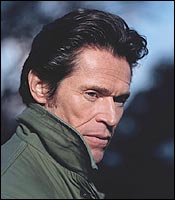
You grew up in Wisconsin. Did you watch a lot of TV?
Not so much. I remember being outdoors a lot when I was a kid, building things, stealing vegetables from farmers’ fields. But my father would go to Chicago every once in a while, and he’d bring back these Super 8 films, these condensed versions of features. A lot of monster movies. Frankenstein, the classics. I remember watching those over and over, playing with the reverse and slow motion.
Were you a bookworm?
I was an athlete. I am embarrassed to say that I read for information then and I still do. Because my name is Dafoe, I remember my brother acting out Robinson Crusoe for me, and trying to read it, but I had trouble getting through it.
Did your family introduce you to music?
I come from a big family, and I really took on the tastes of my older brothers and sisters. From my brothers, it was the Rolling Stones and Dylan. From my sisters, Motown. My parents played a lot of classical music and show tunes. In terms of cultural influences, I was a very late bloomer.
How so?
Well, I grew up in a basically conservative area, where you don’t know anybody that in any really meaningful way is engaged in looking at or making art. I spent a lot of time developing elaborate practical jokes and pranks. In that, I think, are the seeds of my love for performance and conceptual art. Fake dog shit, plastic vomit, ape suits: That was a very important part of my life. I remember getting into an ape suit and picketing Planet of the Apes on opening day.
And you were involved in theater from a young age.
Yes, there was a very good community theater in the area, and it was a whole life. I loved the event, the pretensions, even the little hierarchies. Since then, I’ve always been attracted to those less-than-professional enterprises, where the line between your private life and your professional life gets very blurred.
You’ve developed that kind of relationship with the Wooster Group’s Elizabeth LeCompte.
My parents worked together, and they were workaholics. As a child, I resented that they weren’t around as much, but I saw how they created a meaningful relationship.
But before you found her, you found Theater X in Milwaukee, and toured Europe with the Wooster Group.
I was able to see some of the great companies in the world, like Squat Theater, which later moved to New York. They synthesized classicism with a kind of daredevilishness. I felt it’s what theater should be: inexplicable, not precisely narrative, disturbing, titillating, not purely transgressive either, and with a rigor behind it.
Any visual artists?
I’m always seeing shows that excite me. Do-Ho Suh. Bruce Nauman. I might see a Gary Hill video installation, and it will inform what I do for many months, and then not at all, but he is in my consciousness. Pieces by Jeff Koons, once upon a time, were very important to me. Now? I’m not sure.
Your son is working on a documentary about the Wooster Group. Any favorite documentaries?
I love the classic [D. A.] Pennebaker films [The War Room, Don’t Look Back]. In fact, he was feeling out the group about doing a documentary—and to familiarize us with his work, he showed us three or four of his documentaries. They were incredible. So we freaked out. They were too revealing! We said, “There’s no way we’re going to let you do this with us!”
You have a 21-year-old son. What has he turned you on to?
Well, being a New York City kid, at the age of 10 or 11, he was the first one to turn me on to Snoop [Dogg]. But I just listen to whatever’s around me.
Is there an unsung artist who deserves a Lincoln Center retrospective one day?
Oh, that’s a motherfucker. I was doing this movie called Animal Factory, and one of the inmates sings a kind of elegiac ballad, in the prison. It’s Antony Johnson [of Antony and the Johnsons]. He’s doing just fine—he doesn’t need a plug, but his commitment and his emotionality and the pure beauty of his voice—he brought all these tough guys to tears.
Is there one artwork that’s a kind of touchstone for you?
Well, many years ago, at P.S.1 in Long Island City, there was one thing I loved. It has a kind of gag element to it, and you could see the process. Anyway, you walk into this room and see this pedestal. Simple, white, high as your waist. And you saw something on top of the pedestal moving around. When you got close, you saw there were cockroaches. And that the artist had cut out little fluffy tails and little paper ears and turned them into bunnies. They were cockroach bunnies. Scurrying on top of this pedestal. And they couldn’t climb down because of the weight of these minuscule things glued onto them. It was so beautiful: a little science experiment, a little mortality, a little brutality, a little kitsch—I was in love. It gave me such pleasure that, for a moment, I didn’t worry about anything at all.
The Life Aquatic With Steve Zissou
by Wes Anderson.
December 10.